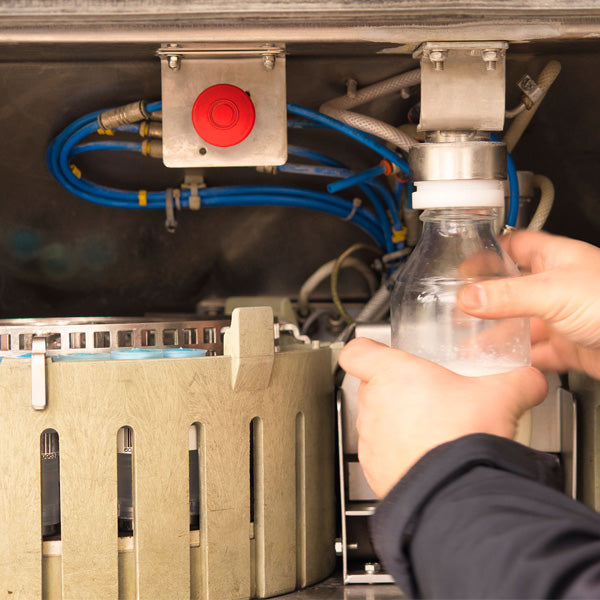Wie wird Käse hergestellt?
Die Käseherstellung ist ein langwieriger Prozess, der viel Erfahrung voraussetzt. Gemischt mit Innovation entstehen somit einzigartige Käsesorten. Erfahre in unserem Blogbeitrag, Schritt für Schritt wie Käse hergestellt wird.

1. Milchproduktion auf dem Bauernhof
Um hervorragenden Käse zu produzieren, braucht es qualitativ einwandfreie Milch. Je nach Käsesorte oder Anforderung einer Sortenorganisation wird die zu verarbeitende Milch 1-2 mal am Tag oder jeden zweiten Tag in der Käserei angeliefert. Entweder bringen die Bauern die Milch selber zur Käserei oder ein Milchsammelwagen holt die Milch direkt auf dem Bauernhof ab. Vereinzelt bringen die Bauern die Milch auch zu einer zentralen Sammelstelle, von wo die Milch zu einem Milchverarbeiter gebracht wird. Die Lagerung und Verarbeitung der Milch müssen ständig unter kontrollierten Bedingungen stattfinden. Die mooh Genossenschaft arbeitet schweizweit mit 18 Transportunternehmen zusammen, um wöchentlich im Schnitt 11-12 Millionen Kilogramm Milch von den Bauernhöfen in die Milchverarbeitungsbetriebe zu transportieren. Insbesondere ist es eine Herausforderung, trotz verschiedenen Milchsorten und Labels eine effiziente Logistik zu gewährleisten.


2. Milchannahme & Milchbehandlung
Die angelieferte Milch muss hohen Qualitätsansprüchen entsprechen, damit diese zu Käse veredelt werden kann. Um die Qualität zu überwachen wird die Milch auf folgende Parameter untersucht:
• Zellzahl, welche einen Rückschluss auf die Eutergesundheit zulässt
• Keimzahl, welche ein Indikator für die Stall- und Melkhygiene ist.
• Hemmstoff, welcher angibt, ob Antibiotika in der Milch vorhanden ist.
• Gefrierpunkt, gibt an ob es zu einer Verwässerung der Milch gekommen ist.
Die Milch wird vor dem Einlass in das Käsekessi auf ca. 30°C erwärmt und der Fettgehalt standardisiert. Bei der Herstellung von Käse aus pasteurisierter Milch, wird diese vor dem Einlaben erhitzt (pasteurisiert). Die milcheigene Flora mit ihren Bakterien und Enyzmen geben dem Käse sein individuelles Aroma.
3. Dicklegen der Milch
Nach der Aufbereitung wird die Milch sorgfältig in das Käsekessi gefüllt und die Dicklegung der Milch beginnt. Der eigentliche Dicklegungsprozess beginnt mit der Beigabe des Labenzyms. Während dieser Zeit bildet sich im weiteren Verlauf eine glatte, homogene Masse oder wie man im Fachjargon sagt, eine Gallerte


4. Bruchbearbeitung und Vorkäsen
Sobald der gewünschte Ausdickungsgrad erreicht ist, wird mit einer Harfe die Gallerte in regelmässige Bruchkörner geschnitten. Je nach dem was für eine Käsesorte hergestellt wird, kann die Grösse des Bruchkorns von klein wie ein Maiskorn bis gross wie eine Haselnuss variieren.
Während dem Rühren wird das Käsebruch-Molkegemisch erwärmt. Diese Erwärmung führt dazu, dass sich das Bruchkorn weiter zusammenzieht und Molke abgibt.
Die Molke ist ein wertvolles Nebenprodukt der Käseproduktion und wird entweder weiterverwertet als Nahrungsmittel oder Schweinen verfüttert. Das Bruchkorn – Molkegemisch wird in Formen gefüllt und gepresst. Dabei wird weiter Molke abgetrennt und die Bruchkörner zum Käselaib gepresst
5. Salzbad
Wie es der Name schon sagt, werden die Käselaibe während diesem Prozessschritt in Salzwasser gebadet. Während einigen Stunden (Weichkäse) bis zu 18 Tagen (Sbrinz) nimmt der Käse dank des Osmose-Effekts Salz auf. Die Salzaufnahme im Käselaib hat einen positiven Einfluss auf die Haltbarkeit des Käses und auf den Geschmak.


6. Reifung
Der Hauptprotagonist des Reifungsprozess ist das enthaltende Kasein (Milchprotein). Während der Lagerung wird dieses Kasein durch Proteasen (eiweissabbauendes Enzym) abgebaut. In der Fachsprache wird dieser Prozess als Proteolyse bezeichnet.
Während des Reifungsprozesses verändert sich einerseits die Textureigenschaft und andererseits entsteht durch die Abbauprodukte ein komplexes Geschmacksbild.
Jede Käsesorte hat seine eigenen, ganz bestimmten Charaktereigenschaften. Damit der Käselaib seine gewünschte Geschmacksnote und Textur entwickeln kann, ist die Käsereifung von entscheidender Bedeutung. Der Käsereifungsprozess ist ein komplexer chemischer Vorgang, der viel Fingerspitzengefühl und Erfahrung braucht. Nur schon kleine Nuancen können zu einem abweichenden Geschmacksbild führen. Faktoren wie die Rohmilchqualität, die Bakterienauswahl, das Klima im Reifungskeller, der pH-Wert oder auch die Herstellungsparameter spielen hierbei eine zentrale Rolle.
7. Reifung: Bakterien- & Kulturenauswahl
Bakterien beginnen nicht erst während der Käsereifung zu wirken, sondern sie sind bereits im Laufe des Käseherstellungsprozesses unverzichtbare Helfer.
Während der ersten 24h bauen die zugesetzten Kulturen die in der Milch enthaltene Laktose (=Milchzucker) zu Milchsäure (=Laktat) ab. Darum ist Käse von grundsätzlich Laktosefrei. Durch diese Ansäuerung der Milch und das zugesetzte Lab kommt es zur Fällung der Milch. Die Auftrennung der Milch in Käsebruch und Molke
Jede Bakterienart hat ihre spezifischen Eigenschaften und diese geben den Käsesorten ihren typischen Charakter. Zusammen mit den Prozessparametern sind sie verantwortlich für die Käsevielfalt.
Durch den Zusatz von sogenannten Herkunftsnachweiskulturen werden Sortenkäse wie Appenzeller, Emmentaler AOP und Tête de Moine markiert, um so die Marken vor Fälschungen zu schützen.


8. Klima & pH-Wert im Reifekeller:
Die Reifung findet unter, für die Sorte typischen Klimata statt. Um eine konstante Käsequalität zu erhalten, sind sowohl die Temperatur als auch die relative Luftfeuchtigkeit ausschlaggebend. Der pH-Wert gibt an, wie sauer oder basisch eine Lösung ist.
Die Messung vom pH ist eine Möglichkeit, den Verlauf während dem Käseherstellungsprozess zu überwachen und zu protokollieren.
Im Zusammenspiel der Faktoren auf den Reifungsprozess sind ebenfalls die Herstellungsparameter zu berücksichtigen. Nur wenn über den ganzen Herstellungsprozess hinweg minuziös alle Vorgaben exakt eingehalten werden, können die komplexen chemischen, enzymatischen und bakteriologischen Prozesse während der Reifung wie geplant ablaufen.

START YOUR SWISS CHEESE SUBSCRIPTION
Simple, convenient and always surprising. Swiss cheese enjoyment at home.
CHEESE BOXES DISCOVER